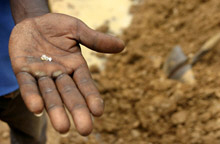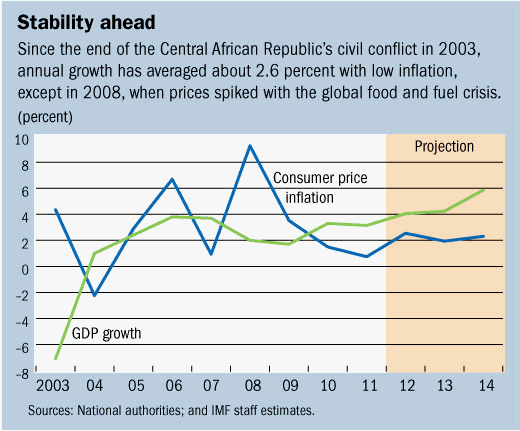
Typical street scene in Santa Ana, El Salvador. (Photo: iStock)
IMF Survey: Central African Republic: Reforms to Remedy Fragility
February 10, 2012
- Central African Republic shows consistent growth since end of conflict in 2003
- Country faces significant challenges to enhance medium-term growth
- Authorities need to implement policies aimed at fostering competitiveness
Despite facing the difficulties of a fragile state, the Central African Republic is showing resilience in the face of the global economic downturn.

Diamond mining in the Central African Republic. Launch of delayed major mining projects would boost growth, government revenue (photo: David Lewis/Reuters)
ECONOMIC HEALTH CHECK
As the country embarks in the consolidation of its reform agenda, some degree of optimism is warranted, the IMF said in its regular review of the country’s economy.
With security in the countryside improving gradually and a strong commitment by the authorities to reforms, the country has achieved macroeconomic stability and maintained economic growth, albeit at modest rates.
Since the end of a destructive civil conflict in 2003, growth has averaged about 2.6 percent per annum, and inflation kept at low single-digit levels, except in 2008 when prices spiked with the global food and fuel crisis (see chart). Fiscal performance has strengthened.

Also, critical public financial management reforms have been implemented with technical assistance from the IMF, the African Development Bank, the European Union and the World Bank. The debt burden has been reduced significantly after the country benefited from development partners’ help, providing fiscal space for critical social programs.
Recovering from, the country pursued sound macroeconomic policies with assistance from the IMF and key development partners. After receiving IMF support twice under the Emergency Post-Conflict Assistance facility, the landlocked central African state completed in September 2010 a 3-year program under the Extended Credit Facility.
Post-conflict risks
Despite these hard-won gains, the authorities continue to address drawbacks of a fragile and post-conflict state: low domestic revenue mobilization, weak capacity and institutions, and an unsettled political context.
Hardly exceeding the rate of population growth, the economic recovery has been too anemic to put a dent in poverty incidence. Improvement in social indicators has stalled as the consequence of limited and inequitable public provision of basic social services. The 2011 United Nations Development Program Human Development Report ranked the country near the bottom (179 out of 187 countries).
Moreover, weak revenue collection constrains the country’s ability to invest in basic infrastructure and pro-poor programs. At less than 10 percent of GDP, the domestic revenue-to-GDP ratio barely covers current expenditures. As a result, the country remains dependent on donor assistance, which for the most part has been quite volatile. Also, deep-rooted structural deficiencies and capacity constraints are prevalent.
As a fragile state, the Central African Republic is confronted with weak administrative capacity and institutions, which negatively affect economic management and constrain resource absorption.
The country also suffers from a lack of diversification stemming from an inhospitable business climate and inadequate infrastructure. As a consequence, the role of the private sector is marginal and domestic demand is undersupplied. The country ranks next to last in the Doing Business 2011 released by the World Bank (182 out of 183 countries).
Another characteristic of fragility lies in the Central African Republic vulnerability to shocks; the economy is prone to setbacks, which have the potential to reverse the progress achieved, as experienced in 2010. Such back-slides often lead to a vicious circle with further freezing of planned foreign aid, when most needed.
The long, drawn-out election process in 2010–11 highlighted the risk of a long absence of donors in fragile states. For instance, efforts at revenue mobilization were not sustained and a number of measures adopted under an IMF supported program resulting in notable gains were not pursued.
Long-term policies
Looking ahead, the authorities need to implement policies aimed at fostering competitiveness in all areas to unleash strong and inclusive growth. The large infrastructure gap will need to be addressed and the reforms momentum maintained. Relieving bottlenecks in road transportation and electricity generation, and reforming the business environment will attract investment in agriculture and mining —the engines for future growth.
In addition, the authorities need to forge ahead with the recommendations of technical assistance they received to reform the revenue administration and strengthen public financial management. Adhering strictly to the established expenditure procedures should be given top priority to restore the centrality of the budget.
The economy is projected to grow at around 5 percent per annum on average in the medium term. The sources of growth in 2012–14 have been identified and longer term growth projections are based on scaled-up infrastructure to be financed by increased concessional external loans and foreign direct investment.
In the longer term, the launching of delayed major mining projects would boost growth and government revenue. Inflation will be contained and the current account is projected to improve. These projections hinge on developments in the euro area, which is the country’s main trading partner and aid donor. Should the euro debt crisis escalate, projected gains would be marked down significantly.
Finally, promised reforms will not materialize without continuous support from the international community. External support is a key factor for cementing the implementation of reforms, and fostering the expectations.


